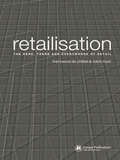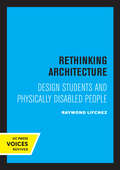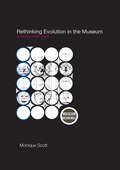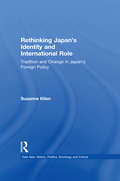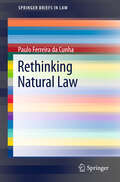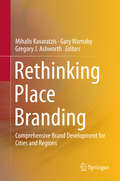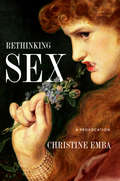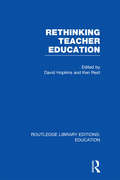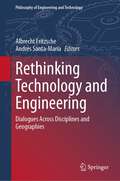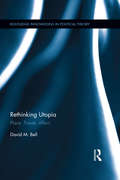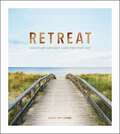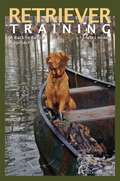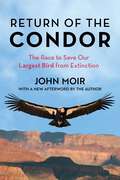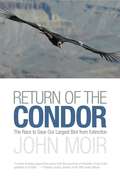- Table View
- List View
Retailisation: The Here, There and Everywhere of Retail
by Robin Hunt Francesca de ChâtelInvestigates the current state of selling, whether this is groceries, politicians, information or motorcars. Unlike any other phenomenon, retailization reflects the complexity and diffusion of information processes and the media in the online market. The authors explore the all-pervasive nature of retail in the physical world, the virtual world and the peripheral spaces in between.Coverage includes:interviews with Asda, MOMA, the Tate Modern, Wal-Mart, Sony, Habitat, Manchester United and Volkswagen, while Bill Mitchell, Dean of Architecture at MIT, architects Jon Jerde, Rem Koolhas and Ben van Berkel, as well as David Peek, psychologist behind the Bluewater Shopping Mall, are all individually interviewed.
Rethinking Architecture: Design Students and Physically Disabled People
by Raymond LifchezThis title is part of UC Press's Voices Revived program, which commemorates University of California Press’s mission to seek out and cultivate the brightest minds and give them voice, reach, and impact. Drawing on a backlist dating to 1893, Voices Revived makes high-quality, peer-reviewed scholarship accessible once again using print-on-demand technology. This title was originally published in 1987.
Rethinking Evolution in the Museum: Envisioning African Origins (Museum Meanings)
by Monique ScottRethinking Evolution in the Museum explores the ways diverse natural history museum audiences imagine their evolutionary heritage. In particular, the book considers how the meanings constructed by audiences of museum exhibitions are a product of dynamic interplay between museum iconography and powerful images museum visitors bring with them to the museum. In doing so, the book illustrates how the preconceived images held by museum audiences about anthropology, Africa, and the museum itself strongly impact the human origins exhibition experience. Although museological theory has come increasingly to recognize that museum audiences ‘make meaning’ in exhibitions, or make their own complex interpretations of museum exhibitions, few scholars have explicitly asked how. Rethinking Evolution in the Museum, however, provides a rare window into visitor perceptions at four world-class museums—the Natural History Museum and Horniman Museum in London, the National Museums of Kenya in Nairobi and the American Museum of Natural History in New York. Through rigorous and novel mixed methods (quantitative and qualitative) covering nearly 500 museum visitors, this innovative study shows that audiences of human origins exhibitions interpret evolution exhibitions through a profoundly complex convergence of personal, political, intellectual, emotional and cultural interpretive strategies. This book also reveals that natural history museum visitors often respond to museum exhibitions similarly because they use common cultural tools picked up from globalized popular media circulating outside of the museum. One tool of particular interest is the notion that human evolution has proceeded linearly from a bestial African prehistory to a civilized European present. Despite critical growths in anthropological science and museum displays, the outdated Victorian progress motif lingers persistently in popular media and the popular imagination. Rethinking Evolution in the Museum sheds light on our relationship with natural history museums and will be crucial to those people interested in understanding the connection between the visitor, the museum and media culture outside of the museum context.
Rethinking Japan's Identity and International Role: Tradition and Change in Japan's Foreign Policy (East Asia: History, Politics, Sociology and Culture)
by Susanne KlienThis paper presents a study of Japan's international role with a special focus on its historical evolution. To that end, the following three pillars lay the necessary theoretical foundations: one, the notions of historical and political identity and a discussion of the ambivalent shapes they have taken in Japan; two, the regional context, an examination of Japan's situation with respect to Asian history as a whole, and finally, the "civilian power" concept as defined by Hanns W. Maull.
Rethinking Natural Law
by Paulo Ferreira da CunhaFor centuries, natural law was the main philosophical legal paradigm. Now, it is a wonder when a court of law invokes it. Arthur Kaufmann already underlined a modern general "horror iuris naturalis". We also know, with Winfried Hassemer, that the succession of legal paradigms is a matter of fashion. But why did natural law become outdated? Are there any remnants of it still alive today? This book analyses a number of prejudices and myths that have created a general misconception of natural law. As Jean-Marc Trigeaud put it: there is a natural law that positivists invented. Not the real one(s). It seeks to understand not only the usual adversaries of natural law (like legalists, positivists and historicists) but also its further enemies, the inner enemies of natural law, such as internal aporias, political and ideological manipulations, etc. The book puts forward a reasoned and balanced examination of this treasure of western political and juridical though. And, if we look at it another way, natural law is by no means a loser in our times: because it lives in modern human rights.
Rethinking Place Branding
by Gary Warnaby Mihalis Kavaratzis Gregory J. AshworthAs Place Branding has become a widely established but contested practice, there is a dire need to rethink its theoretical foundations and its contribution to development and to re-assert its future. This important new book advances understanding of place branding through its holistic, critical and evidence-based approach. Contributions by world-leading specialists explore a series of crucially significant issues and demonstrate how place branding will contribute more to cultural, economic and social development in the future. The theoretical analysis and illustrative practical examples in combination with the accessible style make the book an indispensable reading for anyone involved in the field.
Rethinking Sex: A Provocation
by Christine EmbaPart searing examination, part call to arms—a bold case against modern sexual ethics, from young Washington Post columnist Christine Emba.For years now, modern-day sexual ethics has held that &“anything goes&” when it comes to sex—as long as everyone says yes, and does so enthusiastically. So why, even when consent has been ascertained, are so many of our sexual experiences filled with frustration, and disappointment, even shame? The truth is that the rules that make up today&’s consent-only sexual code may actually be the cause of our sexual malaise—not the solution. In Rethinking Sex, reporter Christine Emba shows how consent is a good ethical floor but a terrible ceiling. She spells out the cultural, historical, and psychological forces that have warped our idea of sex, what is permitted, and what is considered &“safe.&” In visiting critical points in recent years—from #MeToo and the Aziz Ansari scandal, to the phenomenal response to &“Cat Person&”—she reveals how a consent-only view of sex has hijacked our ability to form authentic and long-lasting connections, exposing us further to chronic isolation and resentment. Reaching back to the wisdom of thinkers like Thomas Aquinas and Andrea Dworkin, and drawing from sociological studies, interviews with college students, and poignant examples from her own life, Emba calls for a more humane philosophy, one that starts with consent but accounts for the very real emotional, mental, social, and political implications of sex—even, she argues, if it means saying no to certain sexual practices or challenging societal expectations altogether. More than a bold reassessment of modern norms, Rethinking Sex invites us to imagine what it means to will the good of others, and in turn, attain greater affirmation, fulfillment, and satisfaction for ourselves.
Rethinking Teacher Education (Routledge Library Editions: Education)
by David Hopkins Ken ReidIn recent years there has been a new mood in teacher education. The emphasis is on professional studies, on encouraging trainee teachers to think intelligently about how to tackle problems of the classroom.This book surveys the developments which are taking it further in both Britain and North America. It goes on to argue the case for consolidating the new approach in a thoughtful, structured and comprehensive way. It argues that teacher education should be regarded as a discipline in its own right; that teacher education should be increasingly school focused and problem-centered; that it needs to blend theory more effectively with practice. It argues that teacher training programmes should prepare teachers for an uncertain future in a changing world. This calls for an emphasis on process rather than content in programmes and the preparing of teachers who are self-directed.
Rethinking Technology and Engineering: Dialogues Across Disciplines and Geographies (Philosophy of Engineering and Technology #45)
by Albrecht Fritzsche Andrés Santa-MaríaThis book gives insight into the ongoing work of the forum on Philosophy, Engineering and Technology (fPET), which brings together philosophers and engineers from all over the world to discuss philosophical issues of engineering across disciplinary boundaries. Drawing on presentations and conversations at the fPET 2020 online conference hosted by the Universidad Técnica Federico Santa María in Chile, the chapters establish connections and describe discoveries that have so far been neglected in the discussions held within the young discipline of philosophy of engineering. This volume appeals to students and researchers in the field, through twenty-four proposals brought forward by leading scholars and emerging voices. Pertinent themes covered are:the broader engagement of engineers in problem-solving beyond the scope of their own professionthe exploration of new goals for technology development and the implementation of strategies to reach these goalsthe need for philosophical content and unique pedagogical approaches to engineering education, digital transformations, artificial intelligence and the ethics of online collaboration in social mediacritical revisions of fundamental terminology and theoretical modelling of key concepts in engineering design, ethics, innovation and the anthropology of technology
Rethinking Utopia: Place, Power, Affect (Routledge Innovations in Political Theory)
by David M. BellOver five hundred years since it was named, utopia remains a vital concept for understanding and challenging the world(s) we inhabit, even in – or rather because of – the condition of ‘post-utopianism’ that supposedly permeates them. In Rethinking Utopia David M. Bell offers a diagnosis of the present through the lens of utopia and then, by rethinking the concept through engagement with utopian studies, a variety of ‘radical’ theories and the need for decolonizing praxis, shows how utopianism might work within, against and beyond that which exists in order to provide us with hope for a better future. He proposes paying a ‘subversive fidelity’ to utopia, in which its three constituent terms: ‘good’ (eu), ‘place’ (topos), and ‘no’ (ou) are rethought to assert the importance of immanent, affective relations. The volume engages with a variety of practices and forms to articulate such a utopianism, including popular education/critical pedagogy; musical improvisation; and utopian literature. The problems as well as the possibilities of this utopianism are explored, although the problems are often revealed to be possibilities, provided they are subject to material challenge. Rethinking Utopia offers a way of thinking about (and perhaps realising) utopia that helps overcome some of the binary oppositions structuring much thinking about the topic. It allows utopia to be thought in terms of place and process; affirmation and negation; and the real and the not-yet. It engages with the spatial and affective turns in the social sciences without ever uncritically being subsumed by them; and seeks to make connections to indigenous cosmologies. It is a cautious, careful, critical work punctuated by both pessimism and hope; and a refusal to accept the finality of this or any world.
Retreat: Sanctuary and Self-Care for Every Day
by Sally BrockwayRelax. Refresh. Restart.Amid the commotion of everyday life, finding a few precious moments of “me time” can be challenging. With so many demands on our attention, knowing how to get the most out of our limited downtime is more important than ever.Discover new ways to take some time out with this invaluable guide to finding and creating sanctuary. Whether you’re searching for serenity at home or seeking solace in the great outdoors, this book is packed with self-care tips, calming crafts and delicious recipes to help you relax, recharge and rejuvenate.
Retriever Training: A Back-To-Basics Approach
by Robert MilnerThrough gentle training methods learned from Ray Hunt--the original "horse whisperer"--Robert Milner shows retriever owners how to train the hunting retriever by using its own natural tendencies instead of force. Supplemented with the latest scientific research on how dogs learn, Milner's easy step-by-step training regimen uses positive reinforcement to create the perfect hunting and at-home companion. There is no better training method for the hunter who wants a calm, steady, and obedient retriever.Milner, who has been training retrievers professionally for more than thirty years, reverses the trend of difficult dogs and difficult training methods and offers a system every hunter can easily understand and follow.
Retrospective Columns: Ionic Capitals and Perceptions of the Past in Greek Architecture
by Samuel HolzmanAn innovative study of how and why ancient Greek builders sometimes combined older and contemporary carving styles when making capitalsThe Ionic order of ancient Greek architecture gradually evolved over the course of the sixth century BCE. In Retrospective Columns, Samuel Holzman examines an overlooked group of nine Ionic monuments that are varied in design but have capitals that combine the pillowy, convex volutes of sixth-century Ionia on one side and the crisp concave volutes of more contemporary styles on the other. Such hybrid capitals had a surprising longevity and range, spanning Greece, Italy, and Turkey between 550 and 250 BCE.Why did ancient Greek builders sometimes revert to older carving styles and combine them with newer ones? One old theory is that outdated styles were a labor-saving shortcut—a notion Holzman puts to rest with a marble carving experiment that recreated the volutes of one capital. Rather, he argues that hybrid capitals represented an important parallel to other trends in Greek art, notably &“bilingual&” Attic vases, which combined older and newer painting techniques for sheer visual delight. By studying the chiaroscuro carving effects and painted polychrome decoration of Ionic architecture, Holzman shows that ancient viewers were primed to look for differences in such details, which the book illustrates with many original drawings and diagrams.Exploring works of Ionic architecture from different periods in Ionia, the Cyclades, Athens, and the Northern Aegean, Retrospective Columns demonstrates that their builders ultimately returned to outmoded elements to establish continuity with the past, reinforcing community identities and architectural tradition.
Return from Exile
by Daymond DuckToday's headlines were written over 2,500 years ago when the Hebrews began their return to their Promised Land-the future nation of Israel. God used history-makers Ezra and Nehemiah and prophets Haggai and Zechariah to bring about His perfect plan of restoration. This Smart Guide takes the reader on an unforgettable journey through the Old Testament books of Ezra, Nehemiah, Haggai, and Zechariah to show you how our current--and future--events hinge on the prophetic returns of God's chosen people to their homeland. We are living in exciting times! The reader can discover all God has planned for them as they anticipate His return and ultimate restoration. Be Smart About:Current & Future EventsThe Rebuilt TempleO.T. Prophecies FulfilledJesus's Second ComingThe Promised LandThe Rebuilt Jerusalem WallO.T. Prophecies to be fulfilledAnd More!
Return of the Condor: The Race to Save Our Largest Bird from Extinction
by John Moir&“A heart-stopping saga of the rescue from the very brink of extinction of one of the grandest of all birds.&”—Thomas Lovejoy, president of the Amazon Biodiversity Center. RETURN OF THE CONDOR is the riveting account of one of the most dramatic attempts to save a species from extinction in the history of modern conservation. Features a new Afterword by the author.With the condor&’s population down to only twenty-two birds in the 1980s and their very survival in doubt, the condor recovery team flouted conventional wisdom and pursued a controversial strategy to pull the bird back from the brink of extinction. Thus began the ongoing, decades-long program to reestablish America&’s largest bird in its ancient home in Western skies. Award-winning science writer John Moir takes readers into the backcountry to get to know the recovery program scientists as well as some of the individual condors. These are stories of peril, uncertainty, and controversy. Woven throughout these tales of heartbreak and triumph is the extraordinary dedication of the humans who have sometimes risked their lives for this charismatic, intelligent, and social bird. Despite the program&’s remarkable successes, the condor&’s narrative is still unfolding with a number of challenges remaining. This includes the dilemma of lead poisoning among free-flying condors that is a major obstacle to the bird&’s recovery.The new Afterword presents a compelling examination of the progress and continuing adversity facing the condor recovery effort since the first edition of the book was published.Finalist for the William Saroyan International Writing Prize from the Stanford University LibrariesHonorable Mention from the National Association of Science Writers
Return of the Condor: The Race to Save Our Largest Bird from Extinction
by John Moir&“A heart-stopping saga of the rescue from the very brink of extinction of one of the grandest of all birds.&”—Thomas Lovejoy, president of the Amazon Biodiversity Center. RETURN OF THE CONDOR is the riveting account of one of the most dramatic attempts to save a species from extinction in the history of modern conservation. With the condor&’s population down to only twenty-two birds in the 1980s and their very survival in doubt, the condor recovery team flouted conventional wisdom and pursued a controversial strategy to pull the bird back from the brink of extinction. Thus began the ongoing, decades-long program to reestablish America&’s largest bird in its ancient home in Western skies. Award-winning science writer John Moir takes readers into the backcountry to get to know the recovery program scientists as well as some of the individual condors. These are stories of peril, uncertainty, and controversy. Woven throughout these tales of heartbreak and triumph is the extraordinary dedication of the humans who have sometimes risked their lives for this charismatic, intelligent, and social bird. Despite the program&’s remarkable successes, the condor&’s narrative is still unfolding with a number of challenges remaining. This includes the dilemma of lead poisoning among free-flying condors that is a major obstacle to the bird&’s recovery.Finalist for the William Saroyan International Writing Prize from the Stanford University LibrariesHonorable Mention from the National Association of Science Writers
Return to the Sky: The Surprising Story of How One Woman and Seven Eaglets Helped Restore the Bald Eagle
by Tina Morris&“Three cheers for this splendid, surprising, inspiring book!&”—Sy Montgomery, author of The Soul of an OctopusAlone in a vast wildlife refuge with little direction and no experience, a Cornell Laboratory of Ornithology student found herself responsible for a project of historical importance—to bring the Bald Eagle back from near extinction.In Return to the Sky, Tina Morris, one of the first women to engage in a raptor reintroduction program, shares her remarkable story that is as much about the human spirit as it is about birds of prey.In the spring of 1975, on the eve of the US Bicentennial, Tina was selected to reintroduce Bald Eagles into New York State in the hope that the species could eventually repopulate eastern North America. Young and female in a male-dominated field, Tina was handed an assignment to rehabilitate a population that had been devastated by the effects of DDT. The challenges were prodigious—there was no model to emulate for a bird of the eagle&’s size, for one—but Tina soon found that her own path to self-discovery and confidence-building was deeply connected with the survival of the species she was chosen to protect.Ultimately, Tina spent two years playing &“mother&” to seven eaglets at Montezuma National Wildlife Refuge, east of Seneca Falls in New York. Driven by her passion, she discovered unknown reserves of patience, determination, and grit.At a time when the mass extinction of bird species is a critical global topic, Return to the Sky reminds us how, with a mix of common sense, resilience, and resolve, humans can be effective stewards of the natural world.&“Inspiring . . . [and] proof that one determined person can still make a difference. At a time when the mass extinction of bird species is a critically important global topic, Dr Morris reminds us that humans can still be effective guardians of the natural world.&”—Forbes&“Emotional and inspiring proof that one person can make a difference.&”—Kirkus Reviews&“Inspiring . . . the writing is clear and eloquent . . . Morris expertly blends moving memoir and scientific research in this remarkable and affecting story.&”—Booklist
Reunited: An Investigative Genealogist Unlocks Some of Life's Greatest Family Mysteries
by Samantha Marshall Pamela SlatonAs seen on "20/20"!In this poignant and heartwarming narrative, renowned genealogist Pamela Slaton tells the most striking stories from her incredibly successful career of reconnecting adoptees with long-lost birth parents After a traumatic reunion with her own birth mother, Pamela Slaton realized two things: That she wanted to help other adoptees have happier reunions with their birth families, and that she had the unique skill to do so – a strong ability to find what others could not. Reunited shares the riveting stories of some of Pam's most powerful cases from her long career as an investigative genealogist, and the lessons learned along the way. From the identical twins separated at birth, unknowingly part of a secret study on development, to the man who finally met his birth mother just in the nick of time, Reunited is a collection of these unforgettable moments, told by the woman who orchestrated and witnessed them first-hand. Both heartbreaking and inspiring, they will move anyone who knows the true life-affirming power of family.
Revealing Architectural Design: Methods, Frameworks and Tools
by Philip PlowrightRevealing Architectural Design examines the architectural design process from the point of view of knowledge domains, domain syntax, coherence, framing, thinking styles, decision-making and testing. Using straightforward language, the book connects general design thinking to underlying frameworks that are used in the architectural design process. The book provides historical grounding as well as clear examples of real design outcomes. It includes diagrams and explanations to make that content accessible. The frameworks and their methods are described by what they can accomplish, what biases they introduce and the use of their final outcomes. Revealing Architectural Design is an advanced primer useful to anyone interested in increasing the quality of their architectural design proposals through understanding the conceptual tools used to achieve that process. While it is intended for undergraduate and graduate students of architectural design, it will also be useful for experienced architectural practitioners. For the non-architect, this book opens a window into the priorities of a discipline seldom presented with such transparency.
Revelation, Intellectual Intuition and Reason in the Philosophy of Mulla Sadra: An Analysis of the al-hikmah al-'arshiyyah (Routledge Sufi Series)
by Zailan MorisThis book examines and analyses the legitimacy of the widely held claim that Mulla Sadra's philosophy (al-hikmah al-muta'aliyyah) is a synthesis of principles and doctrines drawn from revelation (wahy), gnosis ('irfan/ma'rifah) and discursive philosophy (al-hikmah al-bahthiyyah). In Mulla Sadra's view, these three major sources of knowledge can be brought together without contradiction and accorded their respective roles in the human quest for true and certain knowledge. This book discusses and demonstrates how Mulla Sadra achieves this synthesis as contained in and exemplified by his text, al-Hikmah al-'arshiyyah or Wisdom from the Divine Throne. An evaluation on whether or not Mulla Sadra's synthesis is successful is also undertaken. The criteria used for the evaluation are the internal coherence of his ideas, their conformity to Islamic teachings and impact on Islamic thinkers after him.
Reverse Diabetes Forever Newly Updated: How to Shop, Cook, Eat and Live Well with Diabetes (Reader's Digest )
by Editors at Reader's DigestThe only guide you'll ever need to mastering diabetes (type 1 or type 2), once and for all. In this comprehensive book, you'll find the latest science and expert advice that enables you--at long last--to take control. You'll learn how to shop, cook, and eat. Learn how to transform your favorite comfort foods into delectable, diet-friendly meals (your family won't know you've changed a thing) that'll get you out of the kitchen fast. Beyond learning to eat well, defeating diabetes means learning how to be more active. It's easier than you think! Cherry-pick from the menu of easy exercises until you've created a 15-minute workout that will trim your tummy and bring your blood sugar numbers down. What's more, you'll come to understand how insidious stress can be. It actually raises blood sugar and lowers your mood, making eating and moving more healthfully a nearly insurmountable challenge. Find scores of smart tips for putting a limit on your daily stresses and banking sleep on the weekend (sleep is the top stress-busting secret of all time). In addition, you’ll discover: • The very best foods to eat every day for stable blood sugar • The “active living pyramid,” a simple guide to the movement you need • The latest studies on how periodic fasting, AGEs (advanced glycation end-products), gut bacteria, and workplace interventions can help beat blood sugar • Tools for tracking your diet, planning doctor visits, monitoring your medication, and more • More than 40 recipes for fresh, delicious, comforting meals, including French fries and chocolate cookies With more than 700 practical tips and simple solutions drawn from the latest science, Reverse Diabetes Forever will help you take charge of your blood sugar once and for all.
Reverse Diabetes: How To Shop, Cook, Eat And Live Well With Diabetes
by Reader'S DigestWith the 12-week Eat, Move, Choose plan as a reliable source of guidance and support, readers of this updated and revised edition of Reverse Diabetes will be well on their way to reversing insulin resistance, losing weight, using less medication, and feeling healthier and more energized. Sifting through mountains of conflicting advice about managing diabetes—from friends, family, colleagues, and more—can often be overwhelming and confusing. Reverse Diabetes eliminates the need for guesswork and provides a streamlined, achievable path to better health. The book&’s 12-week Eat, Move, Choose plan is broken down into concrete, manageable goals, including: Walk at least five days a week Include lean protein at every meal Enjoy seven to eight hours of sleep a night Make active choices The goals are supplemented by step-by-step plans, interactive quizzes, infographics, recipes, and other resources that help readers understand the hows and whys behind each recommendation. With science-backed guidance that takes the most current diabetes research into account plus completely new recipes, meal plans, and other tools to make it a breeze to implement, this updated and revised volume offers an easy-to-follow 12-week challenge shown to lower blood sugar by 25 percent. Roughly 40% of the book will be new, and includes new research, new recipes and meal plans, and new planner/tracker tools. Praise for the previous edition: &“This book is great. I learned a lot about good food choices and foods to avoid, also contains great recipes for diabetics that are healthy and delicious. Would recommend this book to anyone with diabetes or pre-diabetes. The section on calories, sugar, and carbohydrates found in different foods was a big help in planning my every day meals. The exercise section was also very helpful. Already lost 15 pounds.&” —J.S MD &“This book answered so many questions when I was newly diagnosed with diabetes. It&’s a long term book for living and reversing diabetes in addition to being very encouraging and upbeat. The organization of the book and the layout are reader friendly. I have marked it liberally with a hi-lighter and refer to it several times a week.&”—Elizabeth Allanson No big scientific words…. Just regular words and pictures :-) it takes you step by step on HOW to improve your life with Diabetes and how to minimize the symptoms and reverse diabetes. GREAT BOOK!&” —S. McGee &“I found this book educational for me. I like the clear descriptions as well as the variety of menus. I am still reading it, but when finished, I will go back to it often.&” —Gisela M. Damandl &“I love this book. I am not diabetic however I did want to shed unwanted pounds. This book teaches how to keep your sugar steady so you aren&’t craving and constantly hungry. An easy read!&” —Shakala &“Excellent book to read if you are diabetic. Many helpful suggestions were presented. Often it just takes a few lifestyle tweaks to make diabetes management possible.&” —Karen L. Pitts &“My husband found out he had type two diabetes and I knew nothing about it or how to cook and care for him. this book was excellant. price and packaging were great as well. recommended purchase&” —mamad &“This is great, explains everything so well. The recipes are great, I do wish there were more but what&’s there is good. This is a great start to YOU helping yourself fight and get rid of diabetes for good. No need for medications, that&’s what you are working for!&” —Nancy J.
Review Criteria for Successful Treatment of Hydrolysate at the Blue Grass Chemical Agent Destruction Pilot Plant
by Blue Grass Chemical Agent Destruction Pilot Plants Committee on Review Criteria for Successful Treatment of Hydrolysate at the PuebloIn 1993, the United States signed the Chemical Weapons Convention (CWC), an international treaty outlawing the production, stockpiling, and use of chemical weapons. The chemical weapons stockpiles at five of the U. S. chemical weapons storage sites have now been destroyed. At those sites, the munitions were robotically opened and the chemical agent was removed, collected, and incinerated. One of the remaining sites with chemical weapons stockpiles is the Blue Grass Army Depot near Richmond, Kentucky. In this case, caustic hydrolysis will be used to destroy the agents and energetics, resulting in a secondary waste stream known as hydrolysate. "Review Criteria for Successful Treatment of Hydrolysate at the Blue Grass Chemical Agent Destruction Pilot Plant" develops criteria for successfully treating the hydrolysate, identifies systemization data that should factor into the criteria/decision process, suggests potential modifications to suggested treatment that would allow continued onsite processing, and assesses waste disposal procedures. This study further examines the possibility of delay or failure of the existing technology and examines possible alternatives to onsite treatment.
Review of the Public Library Service in England and Wales for the Department of National Heritage: Final Report
by Final ReportThis in-depth study includes data from nine case study areas which have been subjected to detailed examination. The Review assesses the scope and value of public library services currently provided in England and Wales, with a schedule of guidelines and wide-ranging recommendations which lead to a blueprint for services in the new millennium. The Report: examines the changing world within which public libraries have to operate; incorporates significant developments in the UK and abroad over the last ten years; analyses the changing and emerging needs of the public; investigates partnerships, links with other information sectors, and the relationships between library services and other local authority services. It is essential reading for everyone who deals with the public library sector. Contents: Summary; Schedule of recommendations; Scope and structure; The public library's environment; Users and their interests; Functions and services; Funding and control; Repercussions of change; Cooperative endeavours; Appendices; Bibliography; Index.
